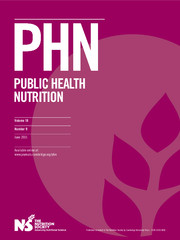Obituary
Professor Fergus Lowe
-
- Published online by Cambridge University Press:
- 08 May 2015, p. 1525
-
- Article
-
- You have access
- HTML
- Export citation
Editorial
Programmes, policies and implementation
-
- Published online by Cambridge University Press:
- 08 May 2015, pp. 1526-1527
-
- Article
-
- You have access
- HTML
- Export citation
Optimizing child-focused nutrition policies: considerations and controversies
-
- Published online by Cambridge University Press:
- 08 May 2015, pp. 1528-1530
-
- Article
-
- You have access
- HTML
- Export citation
Invited Commentary
HOT TOPIC – Implementation of programs and policies
Implementation evaluation of school-based obesity prevention programmes in youth; how, what and why?
-
- Published online by Cambridge University Press:
- 10 December 2014, pp. 1531-1534
-
- Article
-
- You have access
- HTML
- Export citation
Short Communication
Trayless cafeterias lead diners to take less salad and relatively more dessert
-
- Published online by Cambridge University Press:
- 18 November 2013, pp. 1535-1536
-
- Article
-
- You have access
- HTML
- Export citation
Research Papers
An intervention for improving the lifestyle habits of kindergarten children in Israel: a cluster-randomised controlled trial investigation
-
- Published online by Cambridge University Press:
- 12 March 2014, pp. 1537-1544
-
- Article
-
- You have access
- HTML
- Export citation
Students’ beliefs and behaviour regarding low-calorie beverages, sweets or snacks: are they affected by lessons on healthy food and by changes to school vending machines?
-
- Published online by Cambridge University Press:
- 16 January 2015, pp. 1545-1553
-
- Article
-
- You have access
- HTML
- Export citation
Pre-school manager training: a cost-effective tool to promote nutrition- and health-related practice improvements in the Irish full-day-care pre-school setting
-
- Published online by Cambridge University Press:
- 18 October 2013, pp. 1554-1564
-
- Article
-
- You have access
- HTML
- Export citation
‘It’s just so much waste.’ A qualitative investigation of food waste in a universal free School Breakfast Program
-
- Published online by Cambridge University Press:
- 29 December 2014, pp. 1565-1577
-
- Article
-
- You have access
- HTML
- Export citation
Invited Commentary
Beyond the randomised controlled trial and BMI – evaluation of effectiveness of through-school nutrition and physical activity programmes
-
- Published online by Cambridge University Press:
- 14 January 2015, pp. 1578-1581
-
- Article
-
- You have access
- HTML
- Export citation
Research Papers
School nutrition guidelines: overview of the implementation and evaluation
-
- Published online by Cambridge University Press:
- 09 February 2015, pp. 1582-1592
-
- Article
-
- You have access
- HTML
- Export citation
Organizational characteristics and processes are important in the adoption of the Alberta Nutrition Guidelines for Children and Youth in child-care centres
-
- Published online by Cambridge University Press:
- 22 October 2014, pp. 1593-1601
-
- Article
-
- You have access
- HTML
- Export citation
Implementation of A Better Choice Healthy Food and Drink Supply Strategy for staff and visitors in government-owned health facilities in Queensland, Australia
-
- Published online by Cambridge University Press:
- 15 January 2014, pp. 1602-1609
-
- Article
-
- You have access
- HTML
- Export citation
An implementation intervention to encourage healthy eating in centre-based child-care services: impact of the Good for Kids Good for Life programme
-
- Published online by Cambridge University Press:
- 09 January 2014, pp. 1610-1619
-
- Article
-
- You have access
- HTML
- Export citation
Evaluation of compliance to national nutrition policies in summer day camps
-
- Published online by Cambridge University Press:
- 09 June 2014, pp. 1620-1625
-
- Article
-
- You have access
- HTML
- Export citation
Shorter lunch breaks lead secondary-school students to make less healthy dietary choices: multilevel analysis of cross-sectional national survey data
-
- Published online by Cambridge University Press:
- 05 September 2014, pp. 1626-1634
-
- Article
-
- You have access
- HTML
- Export citation
Do schools in Quebec foster healthy eating? An overview of associations between school food environment and socio-economic characteristics
-
- Published online by Cambridge University Press:
- 16 January 2015, pp. 1635-1646
-
- Article
-
- You have access
- HTML
- Export citation
The relationship between school lunch attendance and the food intakes of French schoolchildren aged 3–17 years
-
- Published online by Cambridge University Press:
- 30 January 2015, pp. 1647-1657
-
- Article
-
- You have access
- HTML
- Export citation
Monitoring and surveillance
Nutritional status as assessed by nutrient intakes and biomarkers among women of childbearing age – is the burden of nutrient inadequacies growing in America?
-
- Published online by Cambridge University Press:
- 13 October 2014, pp. 1658-1669
-
- Article
-
- You have access
- HTML
- Export citation
Short Communication
An evaluation of the effectiveness of the flour iron fortification programme in Brazil
-
- Published online by Cambridge University Press:
- 15 September 2014, pp. 1670-1674
-
- Article
-
- You have access
- HTML
- Export citation

